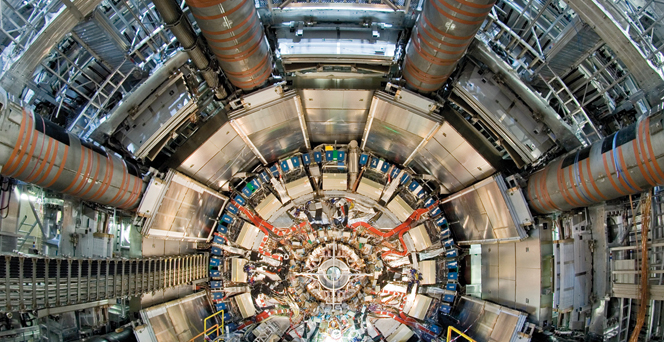URL: https://www.desy.de/research/facilities__projects/lhc_experiments/desy_and_the_lhc/index_eng.html
Breadcrumb Navigation

DESY and the LHC
DESY is significantly involved in the LHC experiments
The proton collisions in the LHC are recorded by four giant detectors – ATLAS, CMS, ALICE und LHCb – located in large underground halls around the accelerator ring. The two biggest experiments, ATLAS and CMS, are managed by large teams of more than 4000 specialists from around the world, who jointly operate the detectors and collect and analyse the data they produce. DESY itself has more than 200 experts working on ATLAS and CMS, and the research centre also provides large computing systems to process the data from the LHC experiments.
Among other things, the DESY experts help analyse the huge amount of data that the detectors collect to search for signs of new particles – a task that is like looking for a needle in a haystack. The DESY researchers develop software tools for the data acquisition as well as for the simulation, reconstruction and analysis of the collisions, and they conduct theoretical studies of the physics at the LHC. DESY specialists regularly travel to Geneva to operate the detectors in shifts or discuss the highly complex data analyses with colleagues from around the globe. The physicists have set up control rooms for both detectors at DESY, which allows them to remotely evaluate the quality of the data the experiments record. In doing so, the DESY scientists benefit from the experience they gained from operating the HERA accelerator in Hamburg.
As part of its Interdisciplinary Data and Analysis Facility (IDAF), DESY also provides large computing and storage systems for the data processing of the ATLAS, CMS and LHCb experiments. This so-called Tier-2 centre is one of the largest among the more than 170 centres of the worldwide LHC computer network and is used by research groups around the world. Closely linked to the Tier-2 centre is the National Analysis Facility (NAF), a computer complex at DESY that is available for physics analysis purposes to all German research groups involved in the LHC.
Upgrade for the LHC
DESY’s expertise in the construction and operation of detectors is also in great demand at the LHC experiments. CERN is planning an expansion of the accelerator, after which the LHC is expected to produce up to ten times more proton collisions than at present. That change will also require an upgrade of the detectors. DESY contributes to the preparations for this “luminosity upgrade”.
Several components of the large detectors are to be completely replaced and fitted with more robust and more sensitive sensors. The problem is that the more collisions occur within a particle detector, the more its sensors are subjected to high-energy radiation. Ordinary chips like the ones used in cell phone cameras would fail within a very short time. DESY researchers are therefore working with industry to find new, extremely robust sensor materials. These are being tested, among other locations, at DESY in Hamburg and Zeuthen.
Radiation resistance is not the only attribute sought in the new sensors – they also need to be finer grained. In the same way that digital cameras are providing more and more megapixels, the researchers aim to substantially increase the resolution of their sensors. In doing so, they are benefiting from the continuing advances in chip manufacturing technology.
At the Detector Assembly Facility (DAF) on the DESY campus in Hamburg, the research centre is working with several universities to build one of the end caps of the silicon tracking detectors for the ATLAS and CMS experiments, each measuring over two metres. The ATLAS end cap, for example, will consist of over 3000 individual modules with a total of 25 square metres of silicon.


